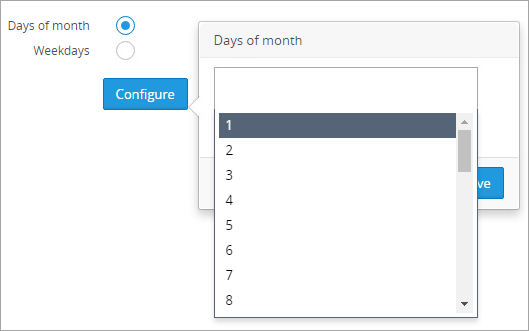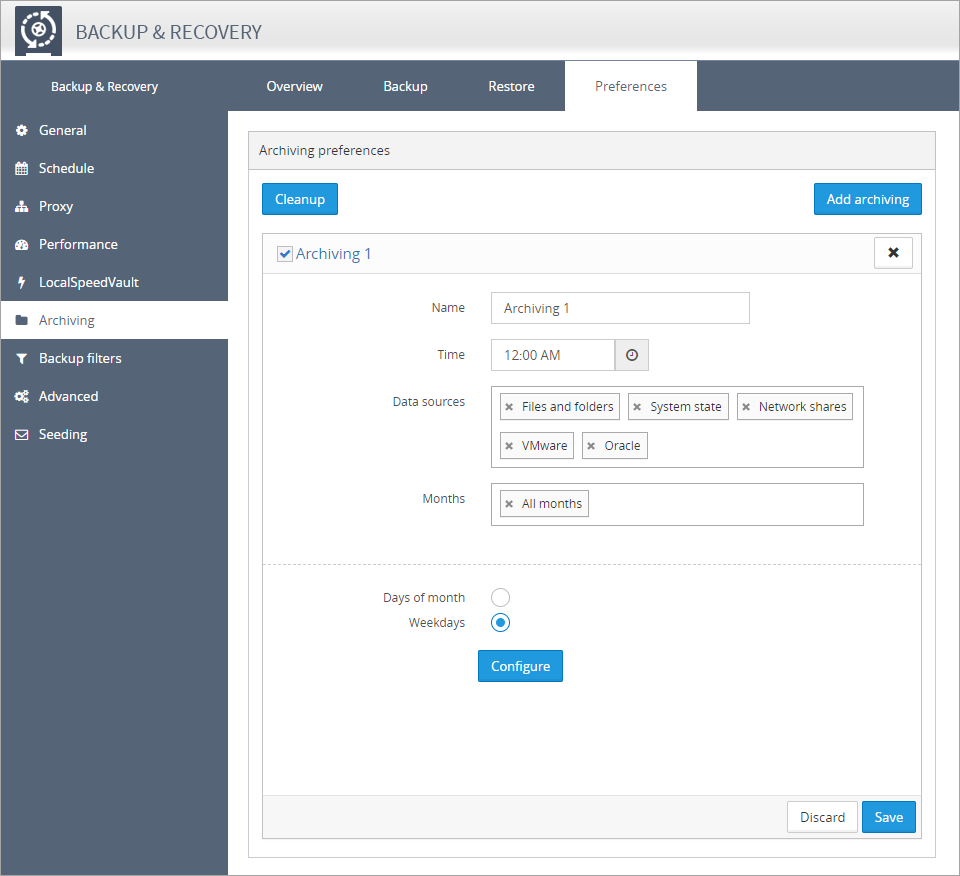Archive Service
If Backup and Recovery options do not appear in N-sight RMM, use Cove instead.
To start a 30-day free trial of Cove:
- Open the app switcher in the Product Bar.
- Select Cove Data Protection (Cove).
Retaining an archive backup may not simply be best practice, so there is a snapshot of your customers data available from outside of the retention period you can restore from, but it can be an industry or regulatory requirement.
In addition to specifying archives for the Files and folder backups in the Backup & Recovery Policy dialog, you can configured archiving for all data sources in the devices Backup Manager.
Archiving is not available for workstations or laptops using Backup & Recovery Documents.
To launch the Backup Manager for a device:
On the computer
- Go to Start > All Programs > Backup & Recovery > Backup Manager
- Click on the desktop's Backup Manger icon (where available)
Or,
From the Dashboard
- Right-click on the target device in the North-pane of the Dashboard (or from the Server, Workstation or Device drop-down)
- Select Backup & Recovery > Open Backup Manager
Manage Archiving
- Select the Preferences tab in Backup Manager
- Navigate to Archiving
- Click Add Archiving (where enabling archiving)
- Enter or edit the archiving information
- Click Save to apply
- Enable or disable the Archive schedule using the checkbox to the left of the schedule name (ticked to enable)
- Click the X button at the right-hand side of the Archive name to delete its schedule
| Archive Setting | Description |
|---|---|
| Name | Enter an archive name for identification |
| Time | The Archive schedule refers to the local time of the computer the Agent is installed on Select the archive time from the drop-down. The next successful backup that runs for the data source after the selected time is marked as the Archive Batch Backup As such we suggest ensuring the entered Day of the Month and Time is set to run before the desired archive backup. For example if the backup runs at 02:00 configure the archive Time to run: for 01:45 |
| Data sources | This dialog displays all Data Sources, click the x against to deselect any Data Sources from this archiving set |
| Months | Click in the Select Months box and choose the required month from the drop-down. Repeat this process to add additional months |
| Days of month^ | Tick Days of the month and choose Configure Click in the Days of the month box to display a list of days and select the required day, repeating this process to add additional days Once complete click Save to apply When choosing the Day of the Month we would suggest taking into consideration months where the date does not exist as the archive will not run on these date, for example the 30 th February, 31st April etc. |
|
Important: Please ensure that either the Days of month or Weekdays are configured. Although the selection will be accepted if these are not set, the archive will never run |
|
| Weekdays^ | Tick Weekdays, choose Configure select the day from the Weekdays drop-down Click in the Select weeks box to display a list of weeks for selection and select the required week, repeating this process to add additional weeks Once complete click Save to apply |
Cleaning up unneeded archiving sessions
If you no longer want to store an archived backup session, you can remove it from storage in the Backup Manager:
- Launch the Backup Manager from the All Devices view or directly on the remote computer
- Go to Preferences > Archiving
- Click Cleanup to view the list of all archived sessions
- Select the sessions to clean up
- Click Cleanup
- Confirm your intention to clean up the selected sessions
This action removes the archived (A) mark from the session. The session is then cleared from storage and is no longer available for recovery.
The Windows Agent automatically removes archive backup records in the Dashboard when deleted in Backup Manager.





